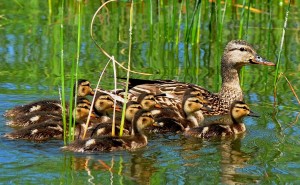Photography courtesy of Lowell Washburn, all rights reserved.
U.S. Fish & Wildlife Service Predicts Strong Duck Migration For 2016
When the leaves turn color and autumn winds blow, Iowa duck hunters can anticipate seeing a strong migration during 2016. That’s the official assessment from this year’s North American Breeding Duck and Habitat Survey released this week by the U.S. Fish & Wildlife Service.
Conducted every year since 1955, the continent-wide annual survey measures trends in duck breeding populations and monitors wetland [pond] indexes across the northern U.S. as well as for large portions of prairie and boreal Canada. A total of 48.4 million breeding ducks was tallied during 2016 – a count similar to last year’s and 38 percent above the 1955-2015 Long Term Average [LTA]. A total of 5 million spring ponds was inventoried; down 21 percent from 2015 and 4 percent below the LTA. The overall decrease in spring pond numbers was attributed to poor spring runoff and lack of early precipitation across parts of the northern U.S. and southern Canada.
Species Highlights: A surveyed breeding population of 11.8 million mallard ducks was reported by the Fish & Wildlife Service during 2016 – a slight [but statistically insignificant] increase from last year’s high count, and 51 percent above the LTA. Green-winged teal populations rose to 4.2 million breeders; a 5 percent increase over last year and an incredible 104 percent above the long term average. A total of 736,000 breeding canvasback ducks was reported; a minor [3 percent] decline from last spring but 26 percent above the LTA. The number of breeding redhead ducks rose to 1.3 million; up 8 percent over last year and 82 percent above the average. Lesser scaup [bluebills] enjoyed a 14 percent increase over last year and are now at the long term average of 4.99 million breeders.
But the substantial decrease in northern prairie ponds did have an impact; not all duck species enjoyed an increase in numbers or even held their own. The number of prairie nesting blue-winged teal declined by 22 percent during 2016 but still remain 34 percent above the LTA. Pintail numbers dropped by 14 percent and are now 34 percent below the long term average. What future spring nesting seasons will hold for North American waterfowl will depend largely on northern prairie snowfalls and spring rainfall. But in the short term at least, overall duck populations are faring well.
In Iowa, duck and goose production ranged from good to excellent and anticipation is already beginning to mount as the fall countdown begins. Iowa hunters have less than a month to go until the first opener of this year’s duck seasons begins on September 3. For those of us sitting smack in the middle of the flyway, there are always plenty of uncertainties. As always, the success of the Iowa duck season will depend on local wetland conditions, developing fall weather patterns and, of course, upon the migratory whims of the birds themselves. One fact is sure. When the temperatures drop and autumn winds blow, a projected fall flight index exceeding 100 million ducks will come winging down the flyways. That’s a forecast guaranteed to stir the blood of any duck hunter.
LW


 Susan Judkins Josten
Susan Judkins Josten Rudi Roeslein
Rudi Roeslein Elyssa McFarland
Elyssa McFarland Mark Langgin
Mark Langgin Adam Janke
Adam Janke Joe Henry
Joe Henry Sue Wilkinson
Sue Wilkinson Tom Cope
Tom Cope Kristin Ashenbrenner
Kristin Ashenbrenner Joe Wilkinson
Joe Wilkinson Dr. Tammy Mildenstein
Dr. Tammy Mildenstein Sean McMahon
Sean McMahon